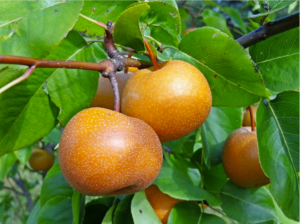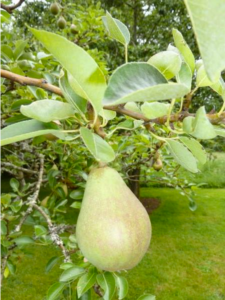When Can You Eat Pears?
go.ncsu.edu/readext?964305
en Español / em Português
El inglés es el idioma de control de esta página. En la medida en que haya algún conflicto entre la traducción al inglés y la traducción, el inglés prevalece.
Al hacer clic en el enlace de traducción se activa un servicio de traducción gratuito para convertir la página al español. Al igual que con cualquier traducción por Internet, la conversión no es sensible al contexto y puede que no traduzca el texto en su significado original. NC State Extension no garantiza la exactitud del texto traducido. Por favor, tenga en cuenta que algunas aplicaciones y/o servicios pueden no funcionar como se espera cuando se traducen.
Português
Inglês é o idioma de controle desta página. Na medida que haja algum conflito entre o texto original em Inglês e a tradução, o Inglês prevalece.
Ao clicar no link de tradução, um serviço gratuito de tradução será ativado para converter a página para o Português. Como em qualquer tradução pela internet, a conversão não é sensivel ao contexto e pode não ocorrer a tradução para o significado orginal. O serviço de Extensão da Carolina do Norte (NC State Extension) não garante a exatidão do texto traduzido. Por favor, observe que algumas funções ou serviços podem não funcionar como esperado após a tradução.
English
English is the controlling language of this page. To the extent there is any conflict between the English text and the translation, English controls.
Clicking on the translation link activates a free translation service to convert the page to Spanish. As with any Internet translation, the conversion is not context-sensitive and may not translate the text to its original meaning. NC State Extension does not guarantee the accuracy of the translated text. Please note that some applications and/or services may not function as expected when translated.
Collapse ▲My youngest daughter catches the bus every morning over in Smallwood. While we don’t live in Smallwood, we are very close so we have a short ride to catch the bus in the mornings. I absolutely love our mornings together! We eat breakfast together then play with our dog Scout until it is time to go. On our way to the bus stop, we typically have great conversations, listen to music (our tastes are somewhat different), or go over the week’s spelling words. Lately, she has been asking questions about a pear tree that is on our route to the bus. The first time she saw the pears she thought they had to be apples. We moved past that and now we are discussing when they will be ready to eat. Do you know how to tell if a pear is ready to harvest?
First, let me begin by saying that there are so many different varieties of pears! We can break the species down further into Asian pears (Pyrus pyrifolia) and European pears (P. communis). The Asian pears are large and round somewhat resembling an apple. They will have greenish-yellow, yellowish-green, or tan skin that may be smooth or have speckles. European pears are typically tear-drop shaped and will be copper, gold to yellow, green, or even red to burgundy. They will all mature a little differently and at a different time but roughly expect the fruit to be ready to pick and eat between August and October.
Pears are considered one of the easier fruits to grow. However, because of the risk of fire blight and difficulty pruning them in the home garden, I have elevated that to moderate in our area. Fire blight is a bacterial disease that will come into any open wound on apples or pears. For this reason, I suggest picking varieties that have resistance to fire blight (European Cultivars with fire blight resistance: Moonglow, Magness, Kieffer, Harrow Delight, Harrow Sweet, Harvest Queen, and Seckel). Most of the Asian pear varieties do not have much if any fire blight resistance. Plan on planting two varieties for pollination.
How do you know when the fruit is ready? Color can be used to get you in the ballpark, harvest when pears begin changing to lighter green or yellow. In the home garden, give the fruit a gentle tug upwards and if it is ready it will come off the tree very easily. It is best to harvest fruit when it is mature and then immediately refrigerate. Allow the pears to ripen at room temperature for a few days before eating.
NC State Extension provides unbiased, research-based information to you the consumer or producer. If you are having an issue in your home garden or landscape, send your questions to Gene Fox, Consumer Horticulture Agent with the North Carolina Cooperative Extension Service, please email Gene at gene_fox@ncsu.edu or call at (252)946-0111. Learn more on Facebook at the Beaufort County Master Gardener page or visit the Extension Office located at 155 Airport Road in Washington, NC!





